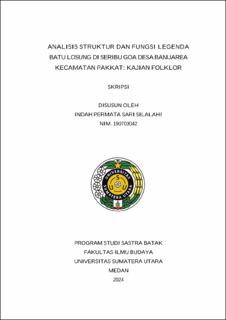Analisis Struktur dan Fungsi Legenda Batu Losung di Seribu Goa Desa Banuarea Kecamatan Pakkat: Kajian Folklor
Analysis of the Structure and Function of the Legend of Batu Losung in Seribu Goa, Banuarea Village, Pakkat

Date
2024Author
Silalahi, Indah Permata Sari
Advisor(s)
Herlina
Purba, Asriaty R
Metadata
Show full item recordAbstract
This research discusses the intrinsic elements of batu losung and the function of the legend of batu losung, aiming to describe the intrinsic elements of batu losung and describe the function of the legend of batu losung. The theory used is structural theory proposed by Nurgiyantoro and the theory of folkloric function proposed by Wiliam R, Bascom. The method used in analyzing this research problem is descriptive qualitative method with field research technique. The results showed that there are (7) seven intrinsic elements, namely: 1) theme: the legend of batu losung is a sacred place and is believed by the community to be a place to concoct natural concoctions that can cure all diseases in the human body. 2) plot/plot contained in the legend of batu losung is a forward plot because the story begins with the initial stage to the end. 3) setting: the setting is in the village of banuarea, in the house, in the hut where the rest in the field, the time setting is in ancient times, the next day, in the afternoon, during the day, the social setting in this legend is believed by the community to be a sacred place and the concoction of herbs that can be accepted and trusted by the community. 4) The characters in the story include; Simanullang clan, Simanullang's wife, Raja, Tiur, and Saut. 5) The point of view in the folklore of the legend of batu losung is the third person telling the story of others. 6) the language style is linking. 7) the mandate of the legend of batu losung is mutual respect and mutual affection. The theoretical concept of the function of batu losung in the research there are (4) four functions: 1) as a form of entertainment, 2) as a means of cultural validation, 3) as an educational tool, 4) as a means of validating cultural institutions.
Collections
- Undergraduate Theses [245]
